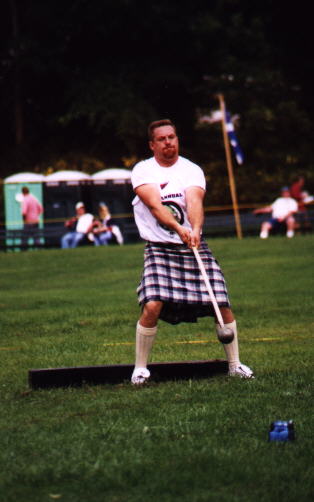VOLUME 3, ISSUE 1July, 2000 TABLE OF CONTENTS
|
A PRIMER FOR THE HAMMER THROWBy Troy Herr, Professional Highland Athlete and Hammer Thrower The hammer thrown in track and field is a 7.26 kg (16 pound) ball made of steel, iron, or brass at the end of a 97 cm (3 feet, 2 inches) flexible stainless steel cable with a triangular steel handle. The thrower turns three or four times and releases the hammer while staying inside a circle that is 2.13 m (7 feet) in diameter, the same size as the shot put. The hammer is one of the most complex events in track and field. Generally, it is an event for larger individuals because of the power needed to generate the force for a throw. Until the fifties, hammer throwers were behemoths who got their distance purely from the strength they possesed. Since that time, the technique has been refined. A combination of strength, speed, coordination, timing, and sound technique is required for success, enabling smaller, quicker throwers to excel. Two examples of this are two of the all-time great throwers from the Soviet Union, Sergei Litvinov and Yuri Sedykh. Litvinov was 1.80m (5 feet 11 inches tall and Sedykh was 1.85m (6 feet 1 inch). These throwers were not tall but were exceptionally fast in the circle and possessed great explosiveness in combination with technique that was far superior to that of any American thrower. There are some characteristics which are common to successful hammer throwers; 1)height- the taller thrower has a theoretical advantage because it is easier for him to get a better release angle, 2) arm length- all other things being equal, the thrower with longer arms will put greater velocity on the hammer for reasons that will be discussed in the next section, 3)excellent rotational speed- the faster the thrower can turn, the faster- the hammer will released and the farther it will go, 4) well-coordinated- the hammer thrower is a complex event and a well coordinated athlete will be able to learn it more quickly, 5) great back and leg strength- these muscle groups are the primary movers in the event and they have to undergo a great deal of stress during the throw. Technique This section is a step-by-step description of the hammer throw followed by a graphical description of the throw. The description will be for a right-handed thower. A left-handed thrower spins clockwise and the directions for the left and right feet would be interchanged. Here are some terms which may need defining: The low and high points of the throw are when the ball is at the bottom or top of its circular path around the thrower. Countering is a term used to describe the way the thrower assumes a sitting position to oppose the pull of the hammer. The position is similar to that of a tug-of-war participant. The double support phase is when the thrower has both feet on the ground. This is the part of the throw where most of the acceleration occurs. The single support phase is when the thrower is in the process of turning and has one foot off the ground. The Winds The thrower starts in the back of the circle with his back to the·throwing area and his feet parallel, about ten centimeters wider than shoulder width. The hammer is either by his right side or between his legs. The thrower starts the hammer in motion around in front of him and up over his head. The low point should be kept around 270 degrees throughout the winds and throw. The thrower should start to stretch his arms out to extend the hammer’s radius and his hips should start to oppose the motion of the hammer. Two or three winds are usually taken before the thrower starts into the next phase of the throw called the transition. The Transition The Turns Three turns are used by beginning throwers. Most world class throwers use four turns so
they can generate more velocity. This increase in turning speed comes at the expense of
some control which is why most throwers cannot use the extra turn. Each turn is performed faster than the one before it so the whole phase has the smooth acceleration desired. The thrower pivots around to 80 degrees and brings his right foot around while rolling around on the outside of the left foot. The right foot has to be kept close to the left leg to make the turn tighter and easier to execute at high speeds. The throwers hips should be slightly ahead of the hammer because without this it would be impossible to accelerate the hammer. The thrower moves his hips in front of the hammer during the double support phase. The plane the hammer travels on becomes increasingly inclined during the turns. During the last turn the angle of inclination should be the release angle. The release angle will be discussed later in this paper. As the thrower goes through the last turn, he plants both feet and begins the final part of the throw - the release. The Release Important Points |
